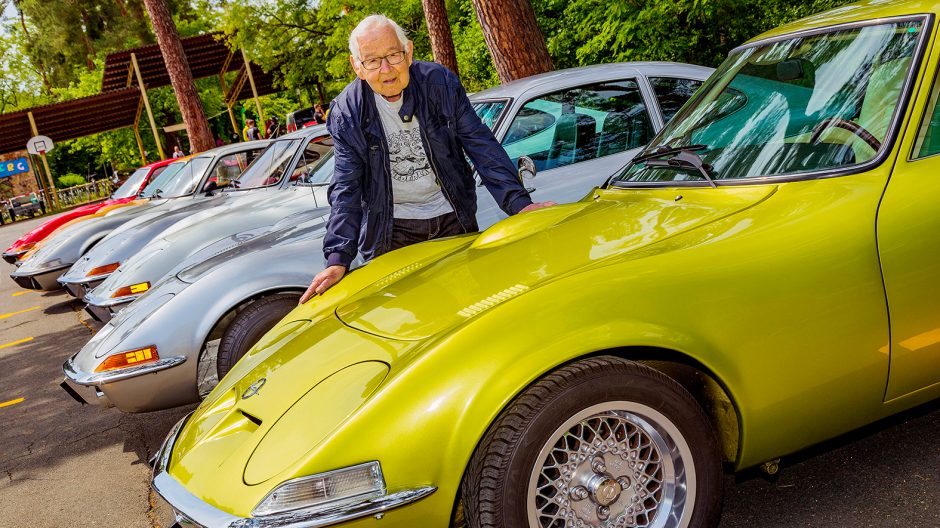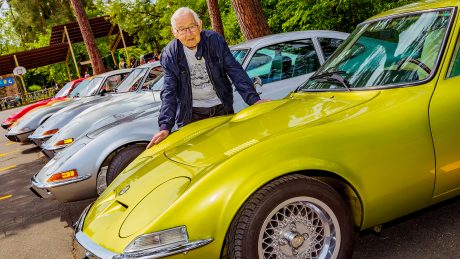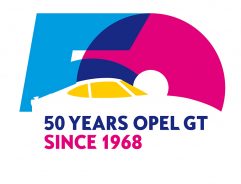
‘It’s the next best thing to flying…’ – these four words are enough to awaken a yearning for the open road, and strong emotions. Just like this slogan made it into the annals of advertising history, the car it advertised become a classic in its own right. The first Opel GT rolled off the assembly line 50 years ago. In this feature series, we will shine a light on this cult coupé to celebrate its 50th anniversary.
Opel GT drivers are free spirits. It’s not like them to fill out a form just to sign up for something. In these circumstances, ‘family’ meet-ups still manage to surprise us, even after all these years – and really push the organizers to their limits. On the morning of the 26th Opel GT Europe-wide meet-up in Seeheim-Jugenheim, we hear that 150 people have already registered. “They’ve been there for a while, but at least another 50 more just showed up on the spot. Parking spaces are gradually running out.”
The GT scene is a tough one to tame. It’s no surprise, then, that it was the sports coupé by Opel that brought rock and roll to the streets of Europe 50 years ago. A true front-mid engine concept based on the Kadett B vehicle architecture conjures up images of rebellion. A steel embodiment of rebellion. And that’s why the coupé, with its timelessly beautiful body, and vigorous, yet curved and elegant lines, is still a good option for those who are wild at heart in 2018. The icons of design that have gathered here in Seeheim-Jugenheim will be examined in person by no less than the father of the GT family.
The Mick Jagger of the Opel GT Scene
The designer arrives at midday, chauffeured by Jens Cooper, an employee at Opel Classic. At 90 years of age, he needs a walking stick to pay tribute to the classic, and cheerfully greets all those who cross his path. A GT aficionado not knowing who Erhard Schnell is – that would be like being a fan of the Rolling Stones and not recognizing Mick Jagger. Schnell became head of the ‘Advanced Studios’ in Rüsselsheim, which brought the legend into being, in 1961.
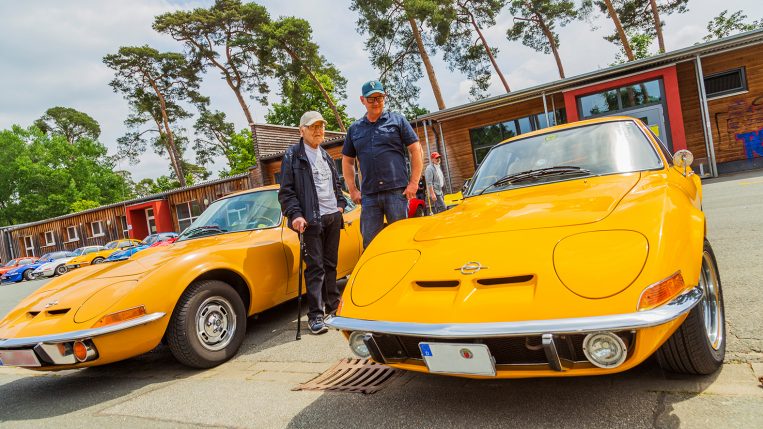
Start me up Designer Erhard Schnell – here, together with Jens Cooper from Opel Classic – is overwhelmed by the amazing scene created by the 45 to 50-year old roadworthy Opel GTs at the Europe-wide meet-up.
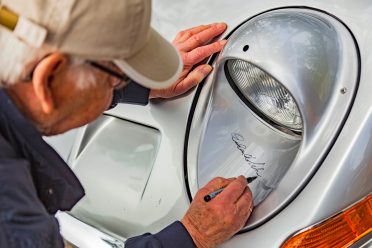
Tattoo you Erhard Schnell is more than happy to sign autographs.
––––––
The mysteries of the Opel GT are best teased out by its knowledgeable ‘family’ members.
–––-–––
The ‘Schuldorf Bergstrasse’ school, which the local GT fan club takes over to host its Europe-wide meet-up for one whole weekend every May, has several yards, which means that Schnell has to head off right away to inspect the different line-ups. His eyes light up when he sees the amazing scene created by the 45 to 50-year old sports coupés. After all, a rolling stone gathers no moss. “Well-maintained, refined – and no one has gone overboard with the spoilers,” the master says, nodding approvingly.
Timeless
“That’s how you recognize that your GT has become a classic,” confirms Marco Siemkes, who is walking beside him. “Only GTs with all original parts and with the original paint are accepted by the community.” Marco Siemkes and his brother André have come to Seeheim-Jugenheim together. Both are mechanics at Opel GT 1900 IG Westmünsterland in western Germany. They recently restored a GT reimport to its former glory for German TV star Horst Lichter. It’s obvious that Schnell is having great fun sitting and chatting with two fellow motorheads. Maurice von Sevecotte, head of the Dutch GT movement, and co-author of a motorsport book on the Opel classic, joins them. The mysteries of the Opel GT are best teased out by its knowledgeable ‘family’ members.
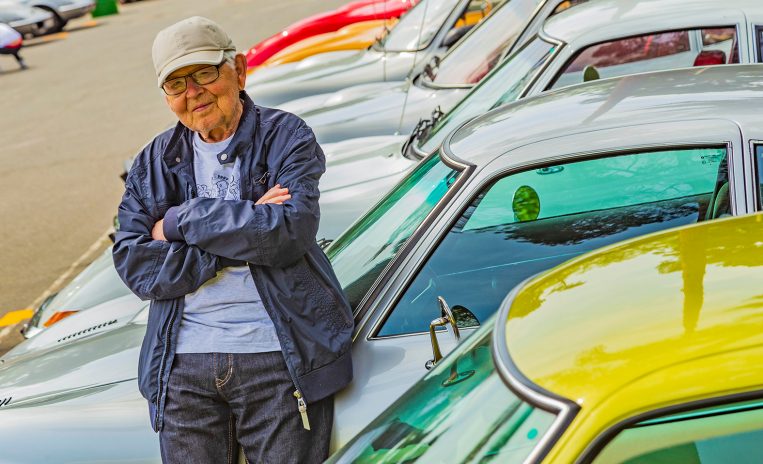
Satisfaction When he first drew up the initial plans for the Gran Tourismo Coupé 55 years ago, Erhard Schnell would never have thought in his wildest dreams that he would be standing here in the middle of a huge fleet of GTs in 2018.
For example: Why were about 50 percent of the 103,463 GTs that were built between 1968 and 1973 sold in the U.S.? Erhard Schnell shrugs. “You tell me,” he says to his fans. “The Americans were 20 years ahead of us when it came to their attitudes to cars,” explains André Siemkes. “They were already buying a second or third car back then. One car per household was the norm in Germany, which meant that the whole family had to squeeze into the back of the car for the family holiday to Italy. Buying a GT was out of the question.” Erhard Schnell nods. “Things weren’t much different for me. I was a young father back then. A GT wouldn’t have been much use to me either.”
Anywhere but the junkyard
The coupé gave Opel such an image boost at the end of the sixties that the company had become a market leader by the beginning of the seventies. “It’s because the GT is an aspirational car,” says van Sevecotte. “While not a lot of people bought it, everyone dreamt about driving one.”
André Siemkes has a simple, enlightening explanation as to why out of almost 100,000 units that have been built in the last five years, so many are passing through the country in top condition after 50 years on the road.
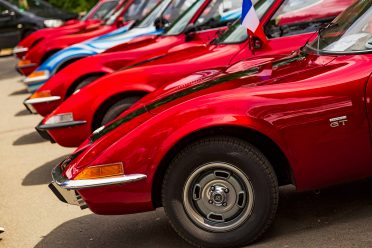
Paint it, Red When the designer of the GT stops by the Europe-wide meet-up, the entire scene forms a guard of honor.
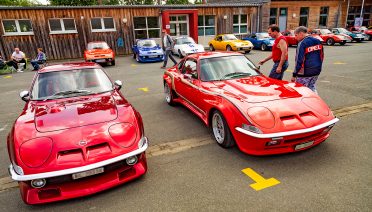
Sympathy for the devil Some fiery interpretations of the Gran Turismo are totally fine, says Erhard Schnell – as long as they look as good as this one, that is.
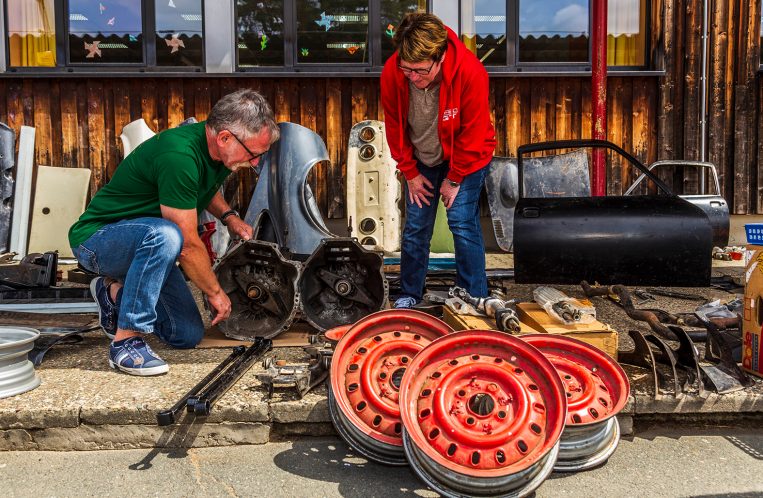
You can‘t always get what you want GT meet-ups are always a hotbed for accessories.
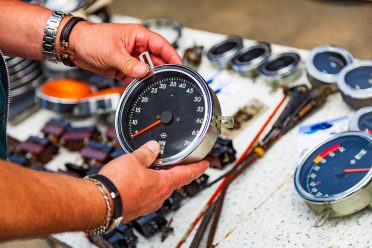
Gimme shelter An Opel GT is afforded special protection among mechanics. Not one of them ends up in the junkyard.
––––––
“Only GTs with all original parts and with the original paint are accepted by the community.”
––––––
“It’s because not one mechanic on earth has scrapped a GT in the last few decades – no matter what condition they found it in, and no matter if and when they would have the time to restore it. You can throw pretty much anything out, but never a GT.” It’s as if they were all part of a secret society preparing for the rebirth of the GT, which has been a great success in the meantime.
Of a different Calibra
“I have to admit that I didn’t follow it much back then,” grins Erhard Schnell, somewhat bashfully. “I had other projects to attend to after the GT.” He’s right – the Manta, Ascona, Kadett, Corsa, and Vectra would all bear Schnell’s signature in the years to come. And he also designed the Calibra right before he went into retirement in 1991. Some aesthetes in the automotive world consider it his most beautiful creation, even if it hasn’t achieved the Opel GT’s cult status – or not yet, at least. Apart from that, Schnell also designed signets, logos, and letterings for the brand.
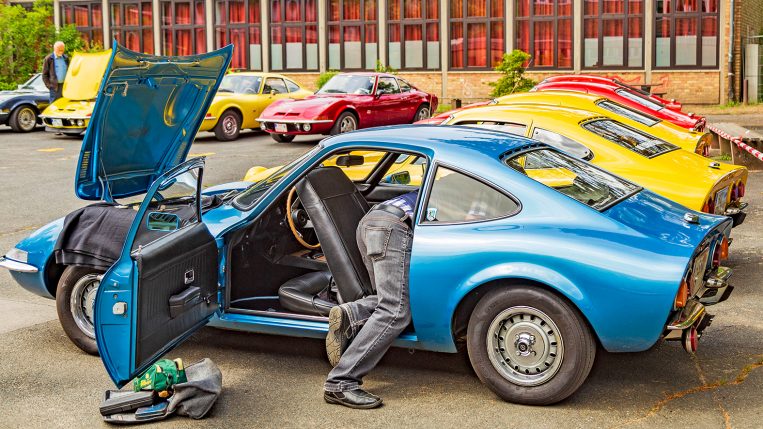
Beast of burden Luggage can only be stored behind the seats – but true GT fans cherish this quirk.
The fact that the first plans for the GT were only drawn up ‘on the side’ because Schnell and his team were actually working on the Rekord C, the ‘bread-and-butter’ car, at the time, that Clare MacKichan, the head of design back then, kept the GT project secret from his own company management between 1962 and 1965, that it attracted so much attention at the IAA automotive exhibition in Frankfurt that series production was commissioned and began in 1968, have all been common knowledge among GT aficionados for a long time now, and don’t need any further discussion among them.
Creative Spirit
The group is much more interested in talking about what the talented designer did outside of his work at Opel. For example, how after he had completed his apprenticeship to become a graphic designer at Offenbacher Werkkunstschule after the Second World War and that he used to spray paint zodiac signs on the walls of houses in Rüsselsheim in the early 1950s – “sadly, they now only exist in photos.” Schnell’s caricatures of his superiors, which were sometimes drawn during meetings and conferences when Schnell’s creative spirit wasn’t receiving enough stimulation, have also achieved cult status. Even weekly schedules that he immortalized with his sketches on the sides have remained intact. “Nobody was actually ever annoyed when I drew caricatures of them,” Schnell reminisces. “Some of these drawings are now cherished by the children of the people I portrayed.”
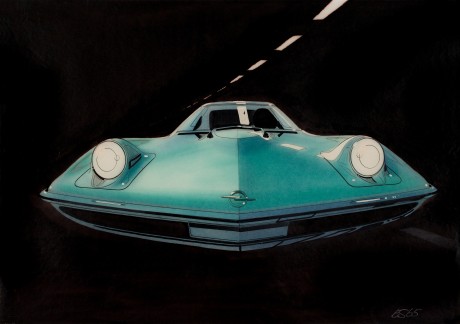
Best of Erhard Schnell is currently exhibiting his GT drawings in the same place he came up with the idea for the coupé – at the ‘Rüsselsheimer Jägerhof’ restaurant.
––––––
Erhard Schnell drew up his first designs for the Opel sports car on a napkin at the ‘Rüsselsheimer Jägerhof’ restaurant almost 55 years ago. The designer will be exhibiting his best work in the restaurant until the end of September.
––––––
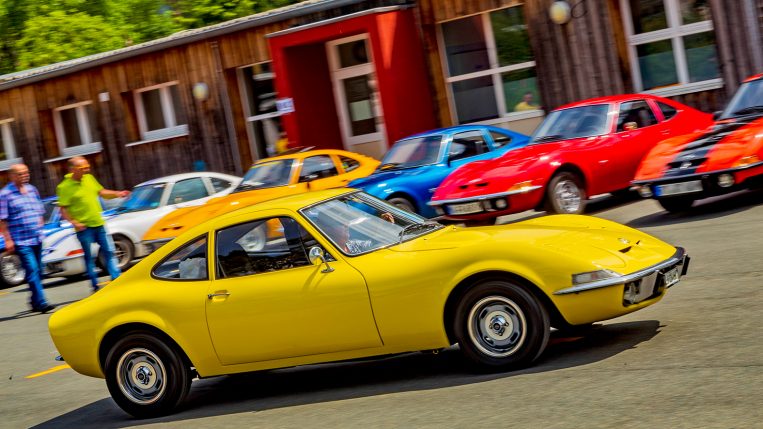
Jumpin‘ Jack Flash An Opel lightning bolt whose curved, elegant lines haven’t aged one bit.

Miss you We’ll cherish the memory of having seen so many beautiful vintage cars in the one place long after the Europe-wide meet-up has passed.
––––––
Which Opel model is Erhard Schnell’s favorite these days? “The current Insignia – and the GT concept, of course.”
––––––
Despite becoming well familiar with computer-aided design, Schnell has always remained a pencil and paper man, who occasionally dabbles in painting. His house in Trebur, near Rüsselsheim, where he lives with his wife Ilse, is adorned with paintings in oil, acrylic, and ink, and he is a member of the local artistic community. Yet he’s never really forgotten about the GT, even today. “I get invited to every meet-up, but I can’t always make it, unfortunately.” As to which Opel model is Erhard Schnell’s favorite these days? “The current Insignia – and the GT concept, of course.”
Spielarten des Kult-Coupés
The chat between these close-knit members of the GT family in Seeheim-Jugenheim continues on into the afternoon. Of course, they ask their patriarch again and again if he’d like to go for a spin in the Opel GT. Schnell declines politely – not today. He drove van Sevecotte’s GT Conrero at a meet-up two years ago, which he says “was a whole lot of fun.” This Italian version of the GT also happens to be his favorite out of all the iterations of his work, “even though the Irmscher and Steinmetz models also have their charms.” This free spirit isn’t opposed to others having a go at replicating his creation, “as long as they don’t go overboard with the spoiler.”
July 2018
